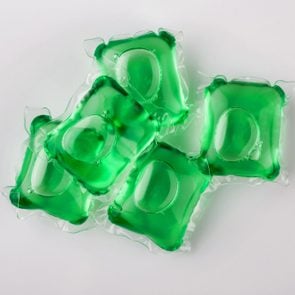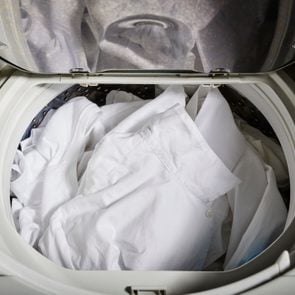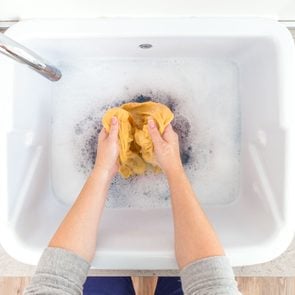HE vs. Traditional Washing Machines: What’s the Difference?
Updated: May 09, 2023
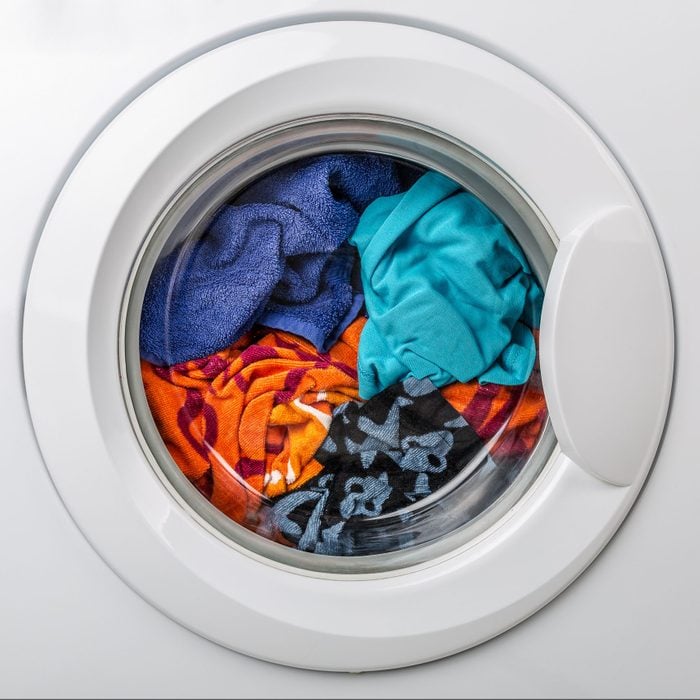
A point-by-point guide to everything you need to know about HE and traditional washing machines.
Many of us don’t realize quite how many washing machine options there are—until we have to go shopping for one. Size, style, how to put in clothes, and even detergent, along with an array of different features, can cause a lot of confusion. Plus, there’s a whole new generation of washing machines to consider: HE washers. They are different from traditional washing machines in nearly every way, including the fact that they have their own set of government-mandated rules.
“HE stands for high efficiency, which refers to improved lower energy and water use by newer clothes washer designs,” explains Mary Gagliardi, aka “Dr. Laundry,” who serves as Clorox’s in-house scientist and cleaning expert. “The term was first used to describe more energy-efficient clothes washers back in the late 1990s when the EPA issued new standards for designs that would reduce the amount of water used to wash a load of laundry, as well as the energy used.”
Fast-forward to today, and those standards still, well, stand. To be coined an HE appliance and receive its laundry symbol, an HE washing machine must meet specific criteria regarding the amount of energy, water, and detergent used per wash. One important note: How you do your laundry and which detergent you use—whether it’s a traditional laundry detergent or an HE detergent—is key for any type of washer, too. So, which washing machine is right for you? Read on to find out. Oh, and while you’re at it, be sure to get one of these best washing machine cleaners, too.
What are HE washers?
In a nutshell, HE washers are simply “washers that are designed to use less water and less energy than traditional washers,” says Laura Johnson, a research and development analyst for LG Electronics. And by “using less water,” we’re talking a lot less—up to 80 percent less than a traditional washer. You can see why they’re deemed “high efficiency.”
How do HE washers work?
HE washers use sensor technology to determine what each load of wash will require, then customize the settings. “HE washers work by sensing how heavy the load is and then adding the appropriate amount of water,” explains Johnson, who adds that washers often need a lot less water than you’d think. “The lower amount of water allows your clothes to rub against each other to work stains and dirt out of them, along with the detergent.” While we’re on the subject, here’s how to tell if you’re using too much detergent.
What do you need to know about high-efficiency vs. traditional washing machines?
As mentioned previously, HE washers use much less water and energy. You won’t see the water filling up the basin the way you will with a traditional washer. “HE washers adjust the mixture of hot and cold water added to reach minimum wash temperatures required for cleaning,” says Gagliardi. “Most of the energy used to wash a load of laundry comes from the energy used to heat the water. That’s why reducing the amount of water used saves so much energy.” In general, here’s what temperature to wash your clothes in.
HE washers can be either top loading or front loading, and while each loading style launders the clothes in a slightly different way, according to Gagliardi, they both “are missing the traditional central agitator that you have in a standard deep-fill, traditional washer.” For laundry that is loaded from the front with a door swinging from one side to another, the laundry is tumbled, she explains, but in a top-loading machine, where you drop the clothes in, it is bounced.
What are the major differences between HE and traditional machines?
Again, the main difference is the amount of water these machines use. To understand exactly how much water is being saved with an HE machine, Gagliardi explains that a “wash cycle that previously used about 40-plus gallons of water for an extra-large load can be reduced to at least half that amount. New HE washers have a minimum fill level and adjust the total amount of water added to the amount of laundry being washed.” She estimates that the wash portion of a launder cycle uses as few as three gallons, but the ultimate amount of water “depends a lot on what type of laundry is being washed—more absorbent textiles like cotton towels use more water than less absorbent fabrics like polyester microfiber sheets.”
In the previous section, we mentioned that HE washers lack an agitator, which is another huge difference. An agitator is essentially a tool inside a traditional washing machine to “help beat the dirt and stains out,” explains Johnson. “Traditional washers work by filling up with large amounts of water so clothes are floating in it,” which is where the agitator comes in to help suds up the load with lots of bubbles. But the catch is that “the agitator is much rougher on clothes than the clothes rubbing against each other.”
How detergent is used and added also varies from HE washing machines to traditional ones. Most HE washers have specific dispensers where you add detergent, bleach, and fabric softeners. It’s important to use the right one for what you’re adding because they “time the addition of each laundry product and ensure proper dilution,” says Gagliardi. That means if you put all three in one dispenser, you may end up with a science project instead of clean laundry.
The pros of HE vs. traditional washing machines
A huge draw of a high-efficiency washer is the high level of water and energy conservation, which brings along a positive sense of doing your part to help the environment.
Traditional laundry machines are still very well-liked and have maintained popularity over time. They also tend to be less expensive, and there is more general awareness about their function and capability versus the newer HE models.
The cons of HE vs. traditional washing machines
Without an agitator, HE machines “do not clean as aggressively, and they rely more heavily on laundry product chemistry to make up the difference,” says Gagliardi. “HE washers can have more variable cleaning because of the way the clothing tumbles or bounces through the wash solution. Not all areas are equally exposed to the wash solution [for the length of the wash cycle].”
Traditional washers, on the other hand, more aggressively agitate the laundry. Gagliardi notes that the agitator can be a double-edged sword: “This can translate to more uniform cleaning—a pro—because items are completely submerged in the wash solution, but it is also harder on clothing—definitely a con.”
An HE’s gentle approach to laundering is kinder to clothes…except when it comes to serious stains. That’s why pretreating stains before washing is an important extra step if you’re using an HE washer. Gagliardi recommends soaking stained clothes overnight with Clorox2 for improved cleaning and a stain-removal boost. “Time isn’t something people like to increase,” she says of the extra step to pretreat stains, but small annoyances aside, it can work wonders on tough-to-remove stains.
Appearance
There are two main types of HE machines: a front-load, which has a small door on the front that opens and closes, and a top-load, which has a solid front and a lid on the top, like a standard washing machine. You’ll also notice the lack of an agitator, which in traditional washing machines stands tall in the center with fin-like shapes to move the laundry back and forth.
Maintenance
“Top-load HE washers don’t require much maintenance,” assures Johnson, adding that LG recommends running a clean cycle once per month. “Front-load washers require a bit more maintenance. Mostly, it’s just that the door needs to be propped open between cycles to allow the washer to dry out. If the door is left shut, the water inside won’t have a chance to evaporate and that can lead to odor and mold buildup.”
Luckily, this icky experience can be avoided by just leaving the door open between cycles. If you haven’t been doing this (and even if you have), you’ll want to take a look at our handy guide on how to clean a washing machine.
Conservation of water and energy
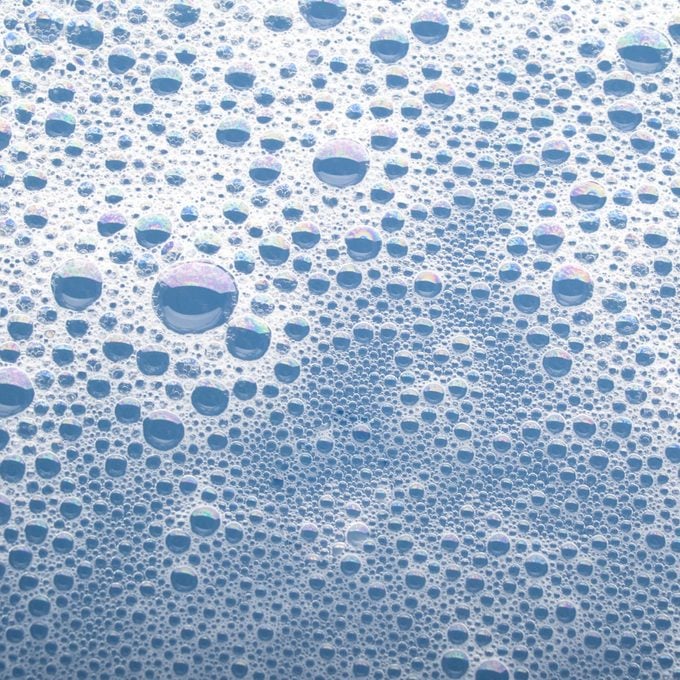
“HE machines are more efficient when it comes to water and energy usage than the traditional, older washing machines,” says Andrew Schueneman, Maytag product marketing manager, quoting the U.S. Environmental Protection Agency’s estimate that HE washers save 6,000 gallons of water per year for an average family. Numbers like that can go a long way toward lowering your household bills.
Traditional machines have faster wash times, says Johnson, but will fill up with lots more water and require more detergent for the agitator to mix into dirty clothes.
Wear and tear on clothing
“When thinking about different types of clothes washers, it helps to understand that different factors contribute to cleaning: mechanical, thermal, and chemical,” says Gagliardi, adding that when you lower one type of energy, you have to increase another.
Mechanical agitation provided by traditional washing machines can be tough on clothes, especially delicates and colors, but without it, clothes may not feel as fresh as you’re accustomed to. HE washers usually wash at a lower water temperature, says Gagliardi, which is gentler on clothing, but “the hotter the water, the more effective the cleaning.” And finally chemical (meaning detergents and other cleansing products) “can help make up for reductions in cleaning that you’d have from more gentle agitation and lower wash temperatures in an HE washer.”
The life span of your washer
As a general rule of thumb, any household appliance performs in accordance with its use and upkeep. HE models are newer and designed to be more efficient overall, and they should last around 10 to 13 years. A traditional washer may not last quite as long, so you might find yourself in the market for a new one a year or two earlier than that. FYI, these are the signs you need a new washing machine.
Cost breakdown
Sticker shock for HE washing machines can also be a drawback for many. Despite saving you money in the long run on your water and energy bills, the upfront cost can be a hurdle. While you can find something simple for around $500, top-of-the-line models can cost you up to $1,600. HE washing machines also require HE laundry detergent, a pricey alternative to standard suds.
Since traditional washing machines haven’t drastically changed over the last few decades, neither has the cost, usually making it the more affordable option. That said, you will spend more on water and detergent over time. Keeping all factors in mind, here are some of the best washer and dryer brands for you to check out.
Troubleshooting potential problems
If you’re an HE newbie and you’re finding that maybe your clothes don’t smell as fresh as they did with a traditional washing machine, Gagliardi recommends adding in a secondary product to boost cleanliness. “I would say that adding a laundry bleach along with your regular detergent is more critical,” she says. “You can use good product chemistry to make up for ways HE washers naturally don’t clean as aggressively.” And here are a few secret ingredients you should be adding to your laundry, anyway.

